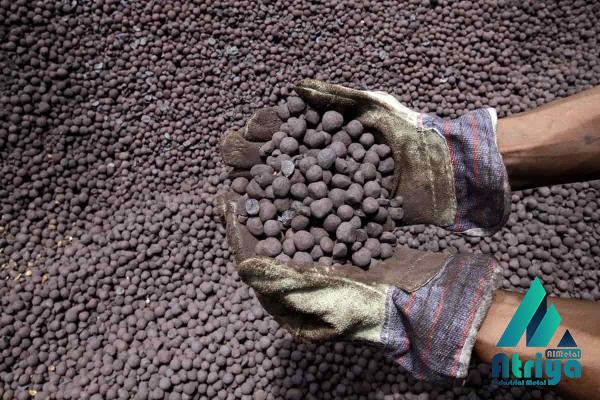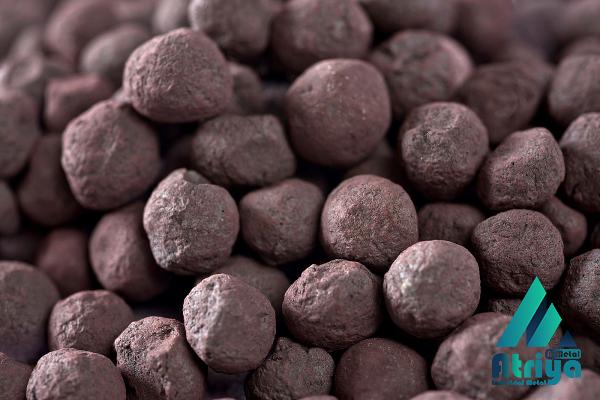Iron ore is a crucial raw material for the global steel industry, serving as a fundamental component from which iron and steel products are manufactured. Among the various types of iron ore deposits found across the globe, four major categories can be distinguished based on their composition and characteristics. This article provides an overview of these four types of iron ore, highlighting their key features, geographic distribution, and utilization in different industries. 1. Hematite: Hematite is one of the most abundant and widely distributed iron ore minerals found globally. It is characterized by its reddish-brown to black color and is composed of iron oxide (Fe2O3). Hematite typically contains 70% iron, making it a highly sought-after resource for steel production. Features: – Hematite has a metallic luster, ranging from brilliant to dull. – It often occurs as a sedimentary rock with fine-grained particles. – Hematite is versatile and can be used directly in blast furnaces or processed into pellets or fines. Geographic Distribution: Hematite deposits are found in countries such as Brazil, Australia, India, and China. In Brazil, the Carajás Mine is one of the world’s largest iron ore mines and contains high-grade hematite. Utilization: As a primary source of iron, hematite is extensively used in the steel industry.
iron
 It is one of the main ores used in blast furnaces, where it serves as both the source of iron and a fluxing agent to remove impurities from the raw materials. Hematite is also processed into iron ore pellets and fines, which are utilized in the production of steel through the steelmaking process. 2. Magnetite: Magnetite is another significant type of iron ore, accounting for roughly 30-40% of the world’s known iron reserves. It is a black mineral with a metallic luster and is composed of iron oxide (Fe3O4). Magnetite has a higher iron content compared to hematite, with grades ranging from 60% to over 70%. Features: – Magnetite has magnetic properties, allowing it to be easily separated from other minerals using magnetic separation methods. – It commonly occurs in igneous and metamorphic rocks, as well as in sedimentary deposits. – Fine-grained, granular forms of magnetite are often referred to as “taconite.” Geographic Distribution: Magnetite deposits can be found in countries such as Australia, Russia, China, and the United States. In Australia, the Pilbara region of Western Australia is known for its vast magnetite resources. Utilization: Magnetite is primarily used in the steel industry due to its high iron content and magnetic properties. The magnetic nature of magnetite allows for efficient separation during processing, enabling manufacturers to produce high-quality iron products. Additionally, magnetite is extensively utilized in heavy concrete, coal washing, water filtration, and various other industrial applications. 3. Limonite: Limonite is a less prevalent type of iron ore compared to hematite and magnetite. It is an amorphous mineral consisting of a mixture of hydrated iron oxide minerals, predominantly goethite (FeO(OH)).
It is one of the main ores used in blast furnaces, where it serves as both the source of iron and a fluxing agent to remove impurities from the raw materials. Hematite is also processed into iron ore pellets and fines, which are utilized in the production of steel through the steelmaking process. 2. Magnetite: Magnetite is another significant type of iron ore, accounting for roughly 30-40% of the world’s known iron reserves. It is a black mineral with a metallic luster and is composed of iron oxide (Fe3O4). Magnetite has a higher iron content compared to hematite, with grades ranging from 60% to over 70%. Features: – Magnetite has magnetic properties, allowing it to be easily separated from other minerals using magnetic separation methods. – It commonly occurs in igneous and metamorphic rocks, as well as in sedimentary deposits. – Fine-grained, granular forms of magnetite are often referred to as “taconite.” Geographic Distribution: Magnetite deposits can be found in countries such as Australia, Russia, China, and the United States. In Australia, the Pilbara region of Western Australia is known for its vast magnetite resources. Utilization: Magnetite is primarily used in the steel industry due to its high iron content and magnetic properties. The magnetic nature of magnetite allows for efficient separation during processing, enabling manufacturers to produce high-quality iron products. Additionally, magnetite is extensively utilized in heavy concrete, coal washing, water filtration, and various other industrial applications. 3. Limonite: Limonite is a less prevalent type of iron ore compared to hematite and magnetite. It is an amorphous mineral consisting of a mixture of hydrated iron oxide minerals, predominantly goethite (FeO(OH)).
Specifications of iron
 Limonite typically contains around 50% iron, making it less desirable for steel production compared to hematite and magnetite. Features: – Limonite is usually brown in color, ranging from yellowish-brown to reddish-brown. – It commonly occurs in soil and sedimentary deposits, often as concretionary nodules or in layered formations. – Limonite is often associated with coal deposits, as it forms through weathering processes involving iron-rich minerals. Geographic Distribution: Limonite deposits can be found in several countries, including Australia, Brazil, China, and the United States. In Australia, the Yilgarn Craton is one of the major regions hosting limonite deposits. Utilization: Although limonite has a lower iron content compared to hematite and magnetite, it can still be utilized in the steel industry, particularly in integrated steel plants where lower iron content ores are suitable. Limonite is also used in pigments and as an ore for sulfur production. 4. Siderite: Siderite is a carbonate iron ore mineral that is less commonly exploited compared to other types of iron ore. It is composed of ferrous carbonate (FeCO3) and typically contains around 48% iron. Siderite’s relatively low iron content makes it less economically viable for large-scale steel production. Features: – Siderite is typically yellowish to brownish in color, often exhibiting a brownish streak.
Limonite typically contains around 50% iron, making it less desirable for steel production compared to hematite and magnetite. Features: – Limonite is usually brown in color, ranging from yellowish-brown to reddish-brown. – It commonly occurs in soil and sedimentary deposits, often as concretionary nodules or in layered formations. – Limonite is often associated with coal deposits, as it forms through weathering processes involving iron-rich minerals. Geographic Distribution: Limonite deposits can be found in several countries, including Australia, Brazil, China, and the United States. In Australia, the Yilgarn Craton is one of the major regions hosting limonite deposits. Utilization: Although limonite has a lower iron content compared to hematite and magnetite, it can still be utilized in the steel industry, particularly in integrated steel plants where lower iron content ores are suitable. Limonite is also used in pigments and as an ore for sulfur production. 4. Siderite: Siderite is a carbonate iron ore mineral that is less commonly exploited compared to other types of iron ore. It is composed of ferrous carbonate (FeCO3) and typically contains around 48% iron. Siderite’s relatively low iron content makes it less economically viable for large-scale steel production. Features: – Siderite is typically yellowish to brownish in color, often exhibiting a brownish streak.
buy iron
 – It commonly occurs as a replacement mineral in sedimentary rocks, particularly those formed in marine environments. – Siderite can exhibit a distinctive rhombohedral crystal structure. Geographic Distribution: Siderite deposits are less widely distributed compared to hematite, magnetite, and limonite. Notable occurrences of siderite can be found in Europe, particularly in Germany, France, and the Czech Republic. Utilization: Though less common in industrial applications, siderite can still be used as a low-grade iron ore. It has historically been used in the production of iron alloys, such as steel, and as a pigment in paint production. Conclusion: Understanding the different types of iron ore is crucial for industries reliant on this vital raw material. Hematite, magnetite, limonite, and siderite each possess distinct characteristics that influence their utilization in various applications. While hematite and magnetite are the most commercially important due to their high iron content, limonite and siderite can still find niche uses in specific industries. With a continued demand for iron and steel globally, the exploration and utilization of these various types of iron ore will remain of utmost importance for years to come.
– It commonly occurs as a replacement mineral in sedimentary rocks, particularly those formed in marine environments. – Siderite can exhibit a distinctive rhombohedral crystal structure. Geographic Distribution: Siderite deposits are less widely distributed compared to hematite, magnetite, and limonite. Notable occurrences of siderite can be found in Europe, particularly in Germany, France, and the Czech Republic. Utilization: Though less common in industrial applications, siderite can still be used as a low-grade iron ore. It has historically been used in the production of iron alloys, such as steel, and as a pigment in paint production. Conclusion: Understanding the different types of iron ore is crucial for industries reliant on this vital raw material. Hematite, magnetite, limonite, and siderite each possess distinct characteristics that influence their utilization in various applications. While hematite and magnetite are the most commercially important due to their high iron content, limonite and siderite can still find niche uses in specific industries. With a continued demand for iron and steel globally, the exploration and utilization of these various types of iron ore will remain of utmost importance for years to come.











Your comment submitted.